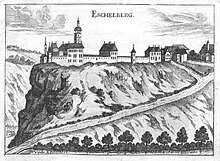Eschelberg Castle
Eschelberg Castle is a castle in the village of Eschelberg in the municipality of St. Gotthard in Upper Austria's Mühlviertel . It emerged from a castle mentioned for the first time in 1205 , which was converted into a palace in the Renaissance style around 1598 .
description
The castle, built at the end of the 16th century, is a three-winged building, the courtyard of which is closed in the west by a wall. It is located on a ridge that slopes steeply on both sides at 396 m above sea level. A. Elevation. Parts of the medieval palace were included in the building structure. The entrance wing is in the north. The renaissance gate made of granite blocks , above which the coat of arms of the Lords of Gera can still be seen, can be reached via a bridge. The adjoining gate hall is built over with a tower with a tent roof . In the south-east of the palace complex is the palace chapel ( consecrated to the Holy Spirit ) with a lancet vault . It is built on the foundations of a former tower.
On the way to the castle, you will pass the former brewery on the left , which is now the studio of the sculptor Magnus Angermeier. The buildings of the former Meierhof are on the right hand .
South of the palace buildings are the ruins of the medieval predecessor building. The core of the hilltop castle , a rectangular building block around a courtyard, lay on the extreme slope of the hill in the south, where high remains of the wall still tower up today.
history

In 1205 Eschelberg was first mentioned in a document with its owner Hainricus de Esilberch. Later the spellings Eschelberch (1287), Eschelwerch (1378) and Eschelburg (1569) appear in documents. Hainricus, presumably belonging to the noble family of Trauner, was a feudal man of the Bavarian Count of Leonberg , who owned the castle. In 1283 the Ministeriale Otto von Traun was enfeoffed with Eschelberg. The feudal sovereignty changed to the diocese of Passau in the 14th century .
In 1560 the lords of Gera , who came from Carinthia , received the fiefdom, whose ownership had meanwhile passed to the Austrian sovereign. In 1598 the von Gera family had the castle converted into a palace. Christoph von Gera, a decree of the gentry of Austria ob der Enns , was hit by a blow at a meeting in the country house in 1609 . His son Erasmus II von Gera (1588–1657), arrested as a Protestant rebel but later converted to Catholicism , sold the Waxenberg estate to Conrad Balthasar von Starhemberg in 1647 . He kept the rule of Eschelberg with Lichtenhaag .
On March 31, 1654, Erasmus von Gera sold his rule of Eschelberg and Lichtenhag Castle, including all accessories, to Konrad Balthasar von Starhemberg (1612–1687).
From then on, Eschelberg formed an administrative unit together with Rottenegg , Oberwallsee and Lichtenhag and had a total of 313 subjects. Eschelberg Castle is still owned by the Starhemberg family to this day.
After 1945 refugees were housed in the castle, in 1962 the castle tower burned down completely due to a lightning strike. The palace complex was renovated in 2010. Today the area can be rented for weddings and company parties.
literature
- Herbert Erich Baumert, Georg Grüll : Castles and palaces in Upper Austria. Volume 1: Mühlviertel and Linz. 3. Edition. Birken-Verlag, Vienna 1988, ISBN 3-85030-046-3 , pp. 83-84.
- Norbert Grabherr : Castles and palaces in Upper Austria. A guide for castle hikers and friends of home. 3. Edition. Oberösterreichischer Landesverlag, Linz 1976, ISBN 3-85214-157-5 .
- Oskar Hille: Castles and palaces of Upper Austria . 2nd Edition. Wilhelm Ennsthaler, Steyr 1992, ISBN 3-85068-323-0 .
- Konrad Schiffmann : Historical place name lexicon of the state of Upper Austria. 3 volumes. Jos. Feichtingers Erben , Linz 1935 (supplementary volume published by the Oldenbourg publishing house, Munich / Berlin 1940).
Web links
- www.schloss-eschelberg.at
- Entry via Schloss Eschelberg to Burgen-Austria
- History and pictures of the castle and ruins at burgenkunde.at.
Individual evidence
- ↑ Magnus Angermeier's website
- ↑ Schiffmann, Ortname Lexicon.
- ↑ Important noble families and rulers in the community Feldkirchen an der Donau: Gera
- ↑ Upper Austrian Provincial Archives (OÖLA): Starhemberger Urkunden, call number 4505 1654 31/3, old call number I / 5 [4357]; the indication of 1647 as the year of sale for Baumert, Grüll, Grabherr and Hille is not applicable.
Coordinates: 48 ° 22 ′ 56 ″ N , 14 ° 7 ′ 4 ″ E




